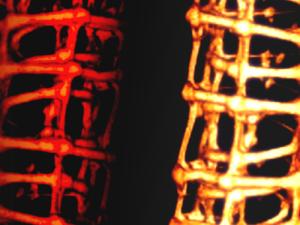On average, 20 people die each day while waiting for an organ transplant, according to the United Network of Organ Sharing. However, scientists at the University of Minnesota envision a day when organ transplants from donors will no longer be necessary. Instead, failing organs will be replaced with ones created by specialized 3D printers. In a giant step toward that goal, researchers have manufactured lifelike artificial organ models using a custom-built 3D printer. These models mimic the exact anatomical structure, mechanical properties, as well as the look and feel of real organs. This research project is supported by two, five-year NIH grants that total over $2.6 million.
Read MoreTags: sell lab equipment, University of Minnesota Twin Cities, Alzheimers, bioprinting, Biomedical Engineering, Research Funding, lab suppliers, UMinn, Lab Product Sales, research news, BioResearch Product Faire, uminn research, NIH awards 2017, nih research funding
The Knight Cancer Institute at Oregon Health & Science University (OHSU) in Portland has just announced an important partnership with San Diego-based bioprinting technology company Organovo. Research into the biology of cancer, especially how it metastasizes, has been complicated in the past by the limitations of animal models and cell cultures, which really don't tell us enough about the workings of cancer within a human being. Organovo creates living, 3-D human tissue using their bioprinting device, the NovoGen MMX (below). The partnership between OHSU and Organovo will allow cancer research at Knight Institute labs to much more closely model the complex architecture of malignancy within the human body, using in vitro tissue. Ultimately this will lead to the development of more accurate therapeutics and pre-clinical trials.
Tags: 2014, 2013, Oregon Health Sciences University, Oregon Health and Science University, Northwest, cancer research, Oregon, Cancer Treatment, bioprinting, BioResearch Product Faire Event, Funding, Front Line event, OR, OHSU, Portland, Northwest Region
 It's getting to the point where there's less and less relevant distinction to be made between life science and physical science research. It was clearer when one lab had petri dishes and the other had circuitboards, but what happens when you have both? That's the case in the Harvard University labs of chemist Charles Lieber and his medical school colleague Daniel Kohane, where the bio research team has successfully created living tissue embedded with tiny nanowires capable of running an electrical current so subtle that it does not harm the tissue cells. These 3D bioelectronic structures could potentially both relay complex information about what's going on inside the tissue and receive signals from an outside source such as instructions for repairs. Several news outlets are calling it cyborg tissue and envision its future use in implants, prosthetics, or even some kind of therapeutic microbot. More immediately it will most likely be used for drug testing in labs, as a precursor to animal or human trials.
It's getting to the point where there's less and less relevant distinction to be made between life science and physical science research. It was clearer when one lab had petri dishes and the other had circuitboards, but what happens when you have both? That's the case in the Harvard University labs of chemist Charles Lieber and his medical school colleague Daniel Kohane, where the bio research team has successfully created living tissue embedded with tiny nanowires capable of running an electrical current so subtle that it does not harm the tissue cells. These 3D bioelectronic structures could potentially both relay complex information about what's going on inside the tissue and receive signals from an outside source such as instructions for repairs. Several news outlets are calling it cyborg tissue and envision its future use in implants, prosthetics, or even some kind of therapeutic microbot. More immediately it will most likely be used for drug testing in labs, as a precursor to animal or human trials.
Tags: Northeast, MIT, cell biology, 2012, Biochemistry, Massachusetts, biorobotics, Cell Research, chemistry research, bioprinting, Boston, BioResearch Product Faire Event, MA, Harvard, Harvard Medical School
By now you've probably heard about 3D bio printing, a bioengineering technique for literally building functional replacement tissue and eventually organs. (Read an earlier blog of ours on the subject.) While still in the early stages of development in terms of actually producing a human organ for transplant, the technology is advancing and critical problems are being met with innovative solutions. In the July issue of Nature Materials, University of Pennsylvania scientists, in conjunction with MIT and Harvard researchers, published an article documenting their success creating a blood vessel network using sugar.
Tags: Pennsylvania, Northeast, University of Pennsylvania, UPenn, 2012, Cell Research, bioprinting, bio research, Philadelphia, BioResearch Product Faire Event, Research, Front Line event, PA, BRPF, scientist solutions, science solution
 Imagine a machine not-unrelated to the inkjet printer on your desk being able to create living organs, tissue and joints for transplant. It’s called bioprinting, and while it’s not going to happen tomorrow, research at major labs across the country indicates it is definitely the future. One of those labs is run by Dr. Ibrahim Ozbolat at the University of Iowa, who teaches in the Department of Mechanical and Industrial Engineering and does research with the Center for Computer-Aided Design's Biomanufacturing Laboratory. In an article published in the January 2012 issue of Mechanical Engineering Magazine (MEM) entitled “Printed Life,” Dr. Ozbolat’s research on microfluidic vessel-like containers to house the printed cells and the fascinating world of 3-D bioprinting are explored in depth. [Photo of Dr. Ozbolat courtesy of University of Iowa]
Imagine a machine not-unrelated to the inkjet printer on your desk being able to create living organs, tissue and joints for transplant. It’s called bioprinting, and while it’s not going to happen tomorrow, research at major labs across the country indicates it is definitely the future. One of those labs is run by Dr. Ibrahim Ozbolat at the University of Iowa, who teaches in the Department of Mechanical and Industrial Engineering and does research with the Center for Computer-Aided Design's Biomanufacturing Laboratory. In an article published in the January 2012 issue of Mechanical Engineering Magazine (MEM) entitled “Printed Life,” Dr. Ozbolat’s research on microfluidic vessel-like containers to house the printed cells and the fascinating world of 3-D bioprinting are explored in depth. [Photo of Dr. Ozbolat courtesy of University of Iowa]
Tags: Midwest, Medical Device Technology, University of Iowa, Iowa, cell biology, bioprinting

